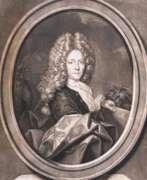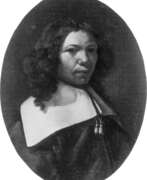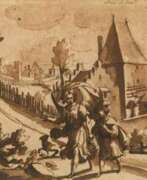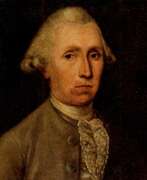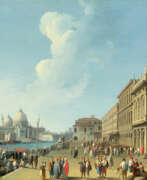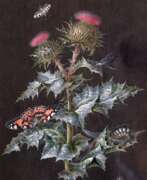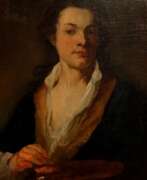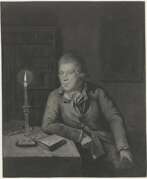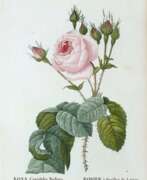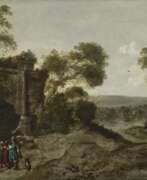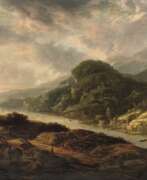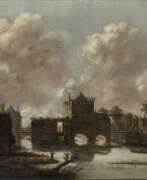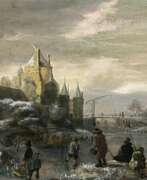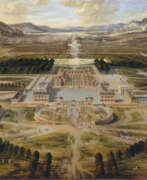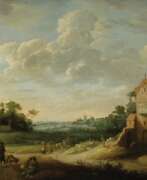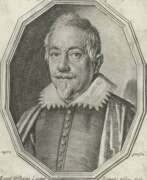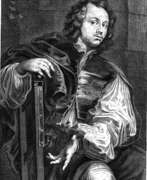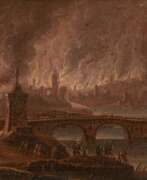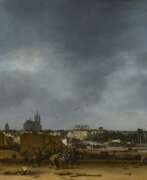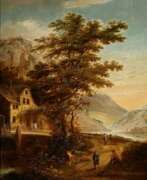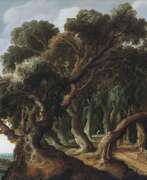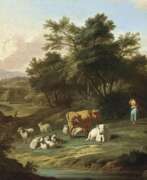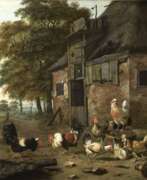Rural landscape Baroque


Barent Avercamp was a Dutch painter. He was taught by his uncle Hendrick Avercamp, who was also a painter. Barent primarily painted scenes depicting Netherlands in winter. He was a member of the Guild of Saint Luke, and traveled around the Netherlands including Zwolle and Zutphen for his settings and inspiration.
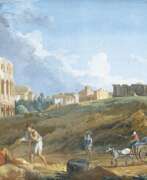

Giovanni Battista Busiri was an Italian painter of landscape and veduta.
Giovanni Battista Busiri followed the style of Gaspard Duguet. His work was greatly influenced by Jan Frans van Bloemen, Hendrik Frans van Lint, Andrea Locatelli and Nicolas Poussin. The figures in Busiri's paintings were executed by other artists.
The works of Giovanni Battista Busini were particularly popular among the wealthy English.


Michiel Carree of Karé was a Dutch painter and decorator of the Golden Age.
Carree was a famous landscape painter: King Frederick of Prussia invited him to Berlin and appointed him court painter. After the king's death, he returned to Holland and was mainly engaged in decorating the palaces of the noble townspeople. Carrée often depicted livestock in his landscapes, and these paintings can now be seen in the Rotterdam Museum.
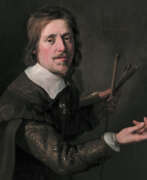

Gijsbert d'Hondecoeter was a Dutch landscape and animalier painter.
Hondecoeter belonged to a family of painters. His father was Gillis d'Hondecoeter and his son was Melchior d'Hondecoeter. Hondecoeter primarily painted works of barnyard fowl. Some of his works can be found at the Rijksmuseum Amsterdam. He became a member of the Guild of St. Luke in Utrecht in 1629. After he died in 1653, his brother-in-law and artist Jan Baptist Weenix continued the training of his son Melchior.
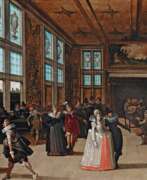

Louis de Caullery was a Flemish painter who is known for his architectural scenes, city views, genre scenes, allegorical compositions and history paintings. He was one of the pioneers of the art genre of courtly gatherings and the garden parties (fête champêtre) in Flemish painting.


Willem de Heusch is a Dutch landscape painter and printmaker.
Willem de Heusch probably studied under Jan Both, as he later painted and etched entirely in his style. De Heusch signed his paintings with his full name beginning with a monogram.
Willem de Heusch was known for his realistic depictions of Dutch landscapes. He used a naturalistic style in his works that was characterized by his attention to detail and skilful use of light and shade.
Although Heusch's style is identical to Botha's, both masters may have been influenced by Claude Lorrain, whose Arcadian art they imitated, during their travels in Italy. Heusch sometimes sketched landscapes for the battle paintings of Jan Molenard.


Pieter de Molijn, a distinguished Dutch Golden Age painter and engraver, was celebrated for his exceptional landscapes, genre pieces, and more. Born in London in 1595 to Flemish parents, he moved to the Netherlands, where he significantly contributed to Dutch art. Molijn was not just a painter; his talents extended to engraving, a testament to his versatility in the art world.
Pieter de Molijn's journey into art took him to Italy and then to Haarlem, where he joined the Guild of St. Luke in 1616, marking the start of a prolific career. His landscapes, known for their sweeping diagonals and tonal unity, helped pioneer a new style that influenced contemporaries and successors alike. Molijn's ability to capture the essence of the Dutch landscape made his works sought after, not just during his lifetime but also in today's art circles.
His works, like the captivating "Landscape with Figures," showcased at The Metropolitan Museum of Art, continue to fascinate art enthusiasts and collectors. Pieter de Molijn's artistry wasn't confined to landscapes alone; his genre pieces and marine scenes also garnered acclaim, reflecting his diverse skills and innovative approach.
For art collectors and experts keen on Dutch Golden Age paintings, Molijn's works represent a blend of technical mastery and artistic vision. Whether it's his detailed landscapes or compelling genre scenes, each piece invites viewers into the world he saw and experienced.
For those who appreciate the finesse of Dutch Golden Age art, staying updated on Pieter de Molijn's works is a must. Whether it's auctions, exhibitions, or private sales, sign up for updates and never miss out on the opportunity to explore or acquire Molijn's timeless masterpieces.
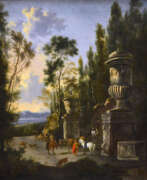

Frederik de Moucheron the Elder was a Dutch landscape painter of the Dutch Golden Age.
Frederik studied under Jan Asselain (1610-1652), then spent three years in Paris before settling in Amsterdam in 1659. De Moucheron painted French, Italian and Dutch landscapes, reproducing with particular care the effects of sunset and gray clouds. Works by this artist are represented in many European art galleries, such as those in St. Petersburg and the Dresden Gallery.
He was the father of the landscape painters Isak de Moucheron and Frederik de Moucheron the Younger.


Pieter de Neyn or Deneyn was a Dutch painter of the Golden Age.
In his youth he worked as a stonemason, but an acquaintance with painters gave him the opportunity to learn the basics of painting. De Neyn was known for landscapes featuring villagers at work and also painted battle scenes. He was also a city sculptor in Leiden.


Gaspard Duguet, also known as Gaspard Poussin, was a French painter specialising in landscape painting. He was born into a family of French painters who settled in Rome.
Gaspard Duguet received his artistic training from his uncle, Nicolas Poussin, who was one of the leading Baroque painters. Duguet's early works were strongly influenced by Poussin's style, which emphasized clarity and orderliness of composition.
In the 1650s, Duguet began to develop a style of his own, characterized by his bold brushwork and vibrant use of colour. He became known for his ability to create dramatic and atmospheric landscapes, often depicting scenes from the Roman countryside.
Gaspar Duguet's paintings have a sense of grandeur and monumentality. His landscapes often feature classical ruins and ancient monuments, giving his works a sense of historical depth and resonance.


Jacques Fouquières, an eminent Flemish landscape painter active in the early 17th century, was celebrated for his detailed and atmospheric landscapes. Born around 1580 and active mainly in France, Fouquières's artistry flourished in a period rich in landscape painting. His style was heavily influenced by the Northern style prevalent during the late 16th and early 17th centuries, characterized by wide, panoramic landscapes with craggy rocks and a blue-greenish palette.
Fouquières's work was not just confined to painting; he was also a skilled draughtsman. His early works, like the "Winter Landscape" of 1617 in the Fitzwilliam Museum, showcase the influence of artists such as Joos de Momper, Jan Brueghel the Elder, Adriaen van de Venne, and Hendrick Avercamp. This particular painting is notable for its portrayal of a cold, wintry scene, exhibiting a mastery of the Northern landscape tradition. However, in his 1622 Forest Landscape, now in the Wallraf–Richartz Museum, Fouquières broke from this tradition, opting for narrower focuses and darker, more concentrated depictions of trees.
One of his notable works, "Landscape with ruins, people and animals," is preserved in The Metropolitan Museum of Art. This piece exemplifies Fouquières's talent in creating engravings, a medium that allowed him to capture intricate details of landscapes and everyday life.
His legacy extends beyond his works; he was a teacher to notable artists like Philippe de Champaigne and Matthieu van Plattenberg. Despite the success in his early career, his life ended in relative poverty, as evidenced by the modest inventory of his estate.
For collectors, auctioneers, and experts in art and antiques, the works of Jacques Fouquières represent a significant period in the history of landscape painting. His contributions to the art world during a pivotal era in European art history continue to be celebrated and studied.
If you have a keen interest in Jacques Fouquières's works or wish to stay informed about sales and auctions of his art, subscribing to updates would be beneficial. This will ensure you receive timely information about new sales and auction events related to his art.


Barend Gael was a Dutch painter and graphic artist of the Dutch Golden Age of painting. He was a pupil of Philips Wouwerman.
Barend Gael was an accomplished painter of Italian landscapes and was known at the Guild of St. Luke's in Haarlem by 1642.
Gael's paintings are noted for their precise composition and use of light and shadow. He often used dark backgrounds to create a sense of depth and contrast, and skillfully used light to emphasise the texture and detail of figures.


Jan Griffier the Younger was an 18th-century painter active in England.
According to the Netherlands Institute for Art History he was the son of Jan Griffier I and the younger brother of Robert. He lived on Pall Mall and influenced the painter Christian August Lorentzen.
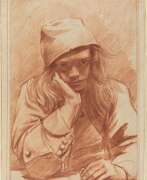

Dirck Helmbreeker or Theodor Helmbreeker was a Dutch Golden Age painter and landscape painter, member of the Guild of St. Luke in Haarlem. He is known for his portraits, Italian landscapes, and genre scenes depicting the daily life of ordinary people (Bambocciade genre).


Albert Jansz. Klomp was a Dutch painter of the Golden Age of Dutch painting who specialised in painting rural landscapes with animals.
Albert Klomp's paintings resemble those of Paulus Potter. Both artists have similar subjects and style, and Klomp's work has been erroneously attributed to Potter in the past.
Klomp's typical pastoral landscapes can be seen in many of the world's museums.
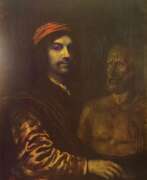

Philips Koninck was a Dutch landscape painter and younger brother of Jacob Koninck.
He painted chiefly broad, sunny landscapes, full of space, light and atmosphere; they are seen from a high perspective, allowing a prominent view of the sky. Portraits by him, somewhat in the manner of Rembrandt, also exist; there are examples of these in the galleries at Copenhagen and Oslo.
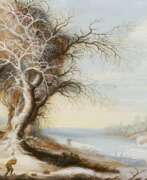

Gijsbrecht Leytens was a Flemish landscape painter of the Early Baroque period. He was famous for his depiction of winter landscapes, which were considered his speciality and were characterised by a highly individualised style. He is considered one of the least studied Flemish painters of the Antwerp School.
Geisbrecht Leitens became a member of the Guild of Saint Luke in Antwerp in 1611. From that time he was entitled to open his own workshop in the city and train apprentices.
The master carefully observed winter nature and birds and developed an individual manner which distinguished him from the philosophical generalisations of Pieter Bruegel the elder or the cosy details and findings of Lucas van Falkenborgh. Trees in his paintings are usually depicted covered in snow, often oddly shaped. The branches of the denuded trees are replete with representations of various birds. The artist's creative style may have been influenced by paintings from the Dutch Mannerism period.


Andrea Locatelli was an Italian painter of landscapes (vedute).
The subject matter most popular with the academic artists of this time was mainly sacred, historical or mythological themes. Locatelli broke with these traditions and concentrated on landscapes, a genre thought to be inferior by the art critics of his day. In fact, he was never allowed induction into the Accademia di San Luca, a very prestigious mark of honor, even though his work was in great demand.
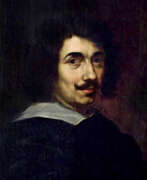

Claude Lorrain was a renowned French artist celebrated for his exquisite landscape paintings. His works, which often depicted idealized landscapes, were infused with a poetic rendering of light, making them influential far beyond his lifetime, especially in England from the mid-18th to mid-19th century.
Claude Lorrain's journey into art began in his youth, though his early life details vary among sources. Some accounts suggest he was apprenticed to a pastry baker before being taken under the wing of artists like Goffredo Wals and Agostino Tassi in Italy, where he spent much of his life. Claude Lorrain's artistic skills flourished in Rome, leading him to join the Accademia di San Luca by 1633. His unique style attracted an international clientele, prompting him to create the Liber Veritatis, a catalog of his works to deter forgeries.
He was a master at integrating architecture within his landscapes, creating serene, harmonious scenes that reflected a nostalgia for a classical past. Works like "Ulysses Returning Chryseis to Her Father" exemplify his ability to evoke mood and atmosphere, capturing the essence of light and space. Claude Lorrain's influence extended to various art forms, inspiring poets like John Keats and setting a precedent in landscape painting that endured through the centuries.
For collectors and art enthusiasts, Claude Lorrain's paintings are not just visual treats but historical artifacts that offer insights into 17th-century landscape painting. His works are housed in prestigious galleries worldwide, serving as a testament to his enduring legacy in the art world.
For those interested in the art and legacy of Claude Lorrain, consider signing up for updates on new product sales and auction events related to this iconic artist. This subscription is an excellent opportunity for collectors and experts in art and antiques to stay informed about Claude Lorrain's enduring influence in the world of art.
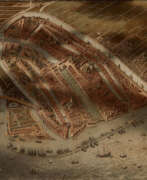

Jan Christiaensz. Micker was a Dutch landscape painter of the Golden Age of Dutch painting.
Jan Micker worked as a painter from 1618 until his death. He was the first teacher of Jan Baptist Wenix and painted staffage in the paintings of Jan Franz Dammeroen, Hans Jurriens van Baden and Joachim Goverts Kamphuizen. His most famous painting is Vogelflücht, which depicts Amsterdam from a bird's eye view. The painting was created around 1652 and is now in the Amsterdam Museum.
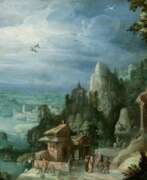

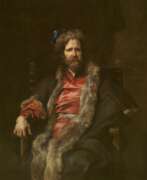

Marten Rijckaert was a Flemish Baroque painter, famous for his landscapes in the Italian manner.
Marten Rijckaert was a pupil of Tobias Verhacht. He was registered as a master at the Antwerp Guild of St Luke's in 1607. Reikart was a close friend of Antonis van Dyck.
His work is characterised by rocky forest landscapes, often with waterfalls, ruins and architecture. These Italian landscapes are close to the works of Flemish painter Paul Brill, and the panoramic concept of his compositions owes a debt to the works of Jan Brueghel the Elder.
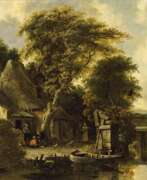

Salomon Rombouts was a Dutch painter of the Dutch Golden Age of painting.
Salomon Rombouts was the son and pupil of the landscape painter Gillis Rombouts and worked in his style. He mainly created landscapes with forests and architecture. The influence of Jacob van Reisdal is noticeable in Rombouts' work.
In 1678 he became a member of the Harlem Guild of St. Luke's. Around 1681 he left for Italy and settled in Florence.
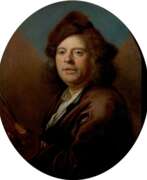

Jan Siberechts was a Flemish landscape painter whose career spanned both his native land and England. Initially, Siberechts developed a personal style of landscape painting in Antwerp, emphasizing Flemish countryside and country life. His work was influenced by Dutch Italianate landscape painters such as Nicolaes Berchem and Karel Dujardin, reflecting a blend of local and Italianate elements. This phase of his career was marked by vivid depictions of the Flemish rural life, with robust country girls in bright attire becoming a signature motif of his paintings.
Siberechts moved to England around 1672, where he significantly contributed to the English landscape tradition. In England, he painted decorations for the Duke's Cliveden House and later, traveled extensively, completing commissions for aristocratic clients. His English landscapes maintained their Flemish character but also started to focus more on universal themes, with less emphasis on figures and more on the scenery itself. These works are characterized by powerful trees, soft light on distant hills, and a relatively dark foreground to highlight the illuminated vistas in the background.
Siberechts is credited as the 'father of British landscape' for his pioneering country house portraits, blending detailed naturalistic views of stately homes into atmospheric landscapes. This innovative approach had a lasting influence on English landscape painting. His work, such as the views of Longleat and the Belsize Estate, represents an important step in the development of topographical painting, merging Flemish influences with the emerging English landscape tradition.
For collectors and experts in art and antiques, Siberechts' oeuvre offers a unique window into the transnational flow of artistic ideas in the 17th century, blending Flemish traditions with the nascent English landscape genre. His paintings, celebrated for their detail and historical topographical interest, can be found in prestigious collections such as the Tate Gallery London and the Victoria and Albert Museum.
For updates on exhibitions, sales, and auction events related to Jan Siberechts' work, art enthusiasts are encouraged to sign up for dedicated newsletters. This ensures that they remain informed about the latest opportunities to explore and appreciate the contributions of this influential Flemish artist to the landscape painting genre.
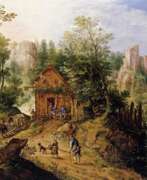

Pieter Stevens the Younger was a Flemish painter and draughtsman known for his landscapes. He left Flanders to work for the court of Emperor Rudolf II in Prague. The circulation of prints made after a series of romantic Bohemian landscape drawings by Stevens and other artists had an important influence on the development of Flemish and Dutch landscape art in the 17th century.


Johann Alexander Thiele was a German landscape painter and printmaker.
He was trained as a printmaker and received his initial training as a painter in Erfurt, but for the most part remained self-taught, copying old paintings.
Thiele painted mainly rural landscapes of Saxony and Thuringia, partly in imitation of the Italian vedettes. He also worked as a court painter and engraver.
Johann Alexander Thiele's son Johann Friedrich Alexander Thiele (1747-1803) also became a landscape painter, draftsman and printmaker.
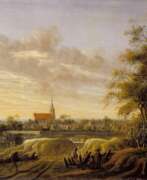

Anthonie Jansz. van der Croos was a Dutch painter and draughtsman of the Golden Age of Dutch painting. He mainly painted landscapes, often in combination with castles or country houses, as well as cityscapes. He was a pupil of Moyses van Uyttenbroeck.
Antoni Jans van der Kroes lived and worked in The Hague from 1634. He became a member of the local St. Luke's Guild in 1647. He was a neighbour of Jan van Goyen, whose work had a great influence on him, so much so that their works were sometimes confused with each other.
In 1656 he became co-founder and secretary of the Confrerie Pictura in The Hague.


Jan van Huchtenburgh was a Dutch painter of the Dutch Golden Age who specialised in battle scenes and landscapes.
Jan van Huchtenburgh was known for his ability to create dramatic and dynamic battle scenes, often depicting historical events of the 17th and 18th centuries. His work is noted for its precision and attention to detail, as well as his use of light and shadow to create a sense of depth and drama.
In addition to battle scenes, Huchtenburg was also a skilled landscape painter. He often depicted scenes of the Dutch countryside with rolling hills, winding rivers and expansive skies.
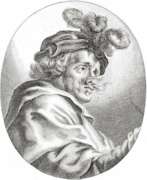

Pieter van Laer was a Dutch painter of the Golden Age, a talented genre painter and printmaker. Pieter van Laer introduced a new genre of painting, bambocciade (after his nickname of bamboccio, little boy). These are paintings depicting scenes from everyday life of ordinary people. In his works, Pieter van Lahr depicted with humor, and sometimes with grotesque and sarcasm, the everyday life of the lower classes of society. Pieter van Lahr is also known for his landscapes and animal representations - he created two series of engravings with animals. He also painted several battle scenes.


Izaak (Isaac) van Oosten was a Flemish Baroque landscape and cabinet painter active in Antwerp.
His landscapes are simple with open spaces and mostly hilly landscapes typically filled with a pond or road and several clusters of trees. There is an overall sense of gentleness and calm in these compositions. An even, gentle light spreads over the entire painting and the trees are untouched by the wind. A number of his landscapes have a Mediterranean flavour.
Works by van Oosten can be found in the collections of the Uffizi, the Museo del Prado, the Hermitage Museum, the Musée des Beaux-Arts d'Orléans, the Museum of Fine Arts of Rennes, the Toledo Museum of Art and other museums.


Ignatius Josephus van Regemorter was a Flemish historical, landscape, and genre painter and engraver. He studied under his father, Petrus Johannes, also in Paris, Antwerp, Brussels, and Ghent.
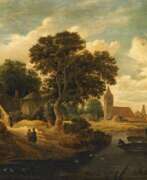

Roelof Jansz van Vries is a Dutch painter known for his landscapes.
Roelof Jansz van Vries was a member of the Harlem Guild of St Luke's from 1657. His work reflected the typical Dutch Golden Age style, characterised by meticulous attention to detail, atmospheric lighting, a sense of depth and realistic depictions of nature.


Simon de Vlieger was a maritime painter of the Golden Age of Dutch painting. He is best known for his paintings depicting the naval fleet of the Republic of the United Provinces of Holland. He painted ships in port, on the high seas, during storms, or shipwreck scenes. Flieger also made tapestries, engravings, and stained-glass windows for the Nieuwe Kerk in Amsterdam.
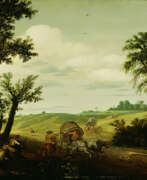

Cornelis Hendriksz Vroom was a Dutch Golden Age landscape painter.
According to the Netherlands Institute for Art History, he was the son of the painter Hendrick Cornelisz Vroom.
Like his father, Vroom is best known for his landscapes and seascapes.
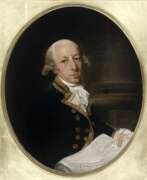

Francis Wheatley was a British painter and illustrator, a Fellow of the Royal Academy of Arts.
He successfully studied at the Royal Academy of Arts, but was soon forced to flee to Ireland, where he established himself as a portrait painter and created one of his most famous works, "The Irish House of Commons". Wheatley also painted genre scenes from rural life, landscapes. Later, back in England, Wheatley collaborated with print publisher John Boydell and created works for the Shakespeare Gallery that were later engraved, and it was his illustrations of novels and various genre subjects that formed Wheatley's enduring reputation as a talented illustrator.
In 1791 Wheatley was elected a full member (Academician) of the Royal Academy of Arts.
Today, Francis Wheatley is best known for his two portraits of Admiral Arthur Phillip, the founder of the permanent British settlements in Australia, which today always illustrate the history of the exploration of the Australian continent.


Jan Jansz Wijnants was a Dutch Golden Age painter.
Wijnants is primarily known for his Italianate landscapes and paintings featuring topography. The painters Nicolaes de Vree and Adriaen van de Velde trained in his studio and his style later had influence on the English artist, Thomas Gainsborough, the German artist Wilhelm von Kobell, and the Dutch artists Anthonie van Borssom and Willem Buytewech.
